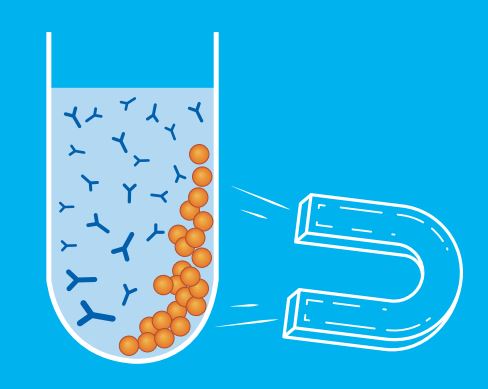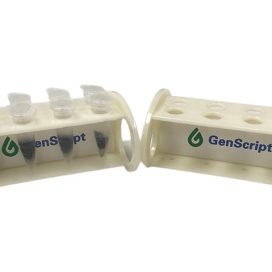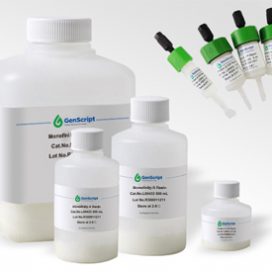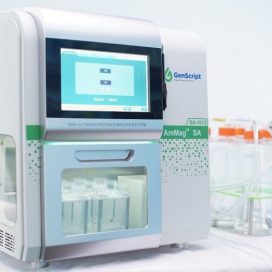Tinh chế protein và kháng thể bằng hạt từ – GeneScript
Hãng sản xuất: GeneScript
- Mô tả
- Thông tin bổ sung
- Catalogue
- Tài liệu tham khảo
Mô tả
Tinh chế protein và kháng thể bằng hạt từ
Hãng: GenScript
GenScript cung cấp giải pháp tinh chế bằng các hạt siêu thuận từ MagBead (paramagnetic MagBeads) nhanh chóng, hiệu quả đối với kháng thể và các protein được gắn epitope (epitope-tagged proteins). Các hạt từ MagBeads được bao phủ bởi các phối tử protein tái tổ hợp cho phép liên kết ái lực đặc hiệu cao với các kháng thể và các epitope-tagged protein. Phương pháp tinh chế protein bằng hạt từ cho phép tinh chế protein trực tiếp từ dịch ly giải tế bào, bỏ qua các bước ly tâm và đơn giản hóa quá trình tinh chế protein. Khả năng liên kết cao, đặc hiệu, nhanh chóng giúp MagBeads trở thành phương pháp lý tưởng cho các ứng dụng yêu cầu thời gian quay vòng nhanh và số lượng mẫu lớn.
Ứng dụng:
- Tinh chế kháng thể
- Tinh chế các protein có đuôi, ví dụ: 6x His, GST, biotin, v.v.
- Tinh chế Protein và kháng thể với công suất cao.
Hướng dẫn lựa chọn hạt từ cho tính chế protein và kháng thể
| Ứng dụng | Tên sản phẩm | Công nghệ | Công suất | Quy cách | Code |
| Tinh chế các Kháng thể từ quy mô nuôi cấy nhỏ tới lớn | Protein A MagBeads | Bắt giữ kháng thể thông qua protein tái tổ hợp (recombinant protein) A hoặc G | >10 mg IgG thỏ/ml hạt từ lắng | 4 ml | L00273 |
| Protein A MagBeads MX | >30 mg IgG người/ml hạt từ lắng | 4 ml | L00672 | ||
| Protein G MagBeads | > 10 mg IgG dê/ml hạt từ lắng | 2 ml | L00274 | ||
| Protein G MagBeads MX | > 25 mg IgG người/1 ml hạt từ lắng | 4 ml | L00673 | ||
| Protein A/G MagBeads | > 10 mg IgG dê/ml hạt từ lắng | 2 ml | L00277 | ||
| Tinh chế kháng thể ổn định kiềm (Alkaline stable antibody) | AmMag™ Protein A Magnetic Beads | Bắt giữ kháng thể thông qua protein tái tổ hợp A chịu kiềm (alkaline- tolerant recombinant protein A) | > 40 mg IgG người/1 ml hạt từ lắng | 4 ml | L00695 |
| Tinh chế His-tagged proteins | Ni-charged MagBeads | His-tagged protein được bắt giữ thông qua ion niken đã được tích điện. | 5 – 20 mg 6×His-tagged protein (27 kD)/ml hạt từ lắng | 8 ml | L00295 |
| AmMag™ Ni Magnetic Beads | His-tagged protein được bắt giữ thông qua phối tử TED tích điện niken (nickel-charged TED ligand). EDTA và kháng DTT. Trong trường hợp không có các phức hợp chelate, có thể tái sử dụng hơn 100 lần. | > 10 mg 6x His-tagged protein/ml hạt từ lắng | 4 ml | L00776-4 | |
| 40 ml | L00776-40 | ||||
| 400 ml | L00776-400 | ||||
| Tinh chế GST-tagged proteins | Glutathione MagBeads | GST fusion protein được bắt giữ thông quan giảm glutathione | 20 – 30 mg GST/ml hạt từ lắng | 8 ml | L00327 |
| Tinh chế phân tử được đánh dấu bởi biotin | Streptavidin MagBeads | Phân tử được đánh dấu bởi biotin được bắt giữ bằng cách kết hợp với streptavidin | > 60 nmol free biotin /ml hạt từ lắng | 2 ml | L00424 |
| * Mỗi quy cách bao gồm 75% dung dịch bảo quản. | |||||
Thông tin bổ sung
| Thương hiệu | GeneScript |
|---|
Trích dẫn tài liệu tham khảo
- Y Kuroda., et al. Improved capillary electrophoresis method for the analysis of carbohydrate-deficient transferrin in human serum, avoiding interference by complement C3. J Pharm Biomed Anal. 2013 Mar 25;76:81-6.
- Hsieh YH., et al. Histone deacetylase inhibitor suberoylanilide hydroxamic acid suppresses the pro-oncogenic effects induced by hepatitis B virus pre-S2 mutant oncoprotein and represents a potential chemopreventive agent in high-risk chronic HBV patients. . 2013 Feb;34(2):475-85.
- Ferreira E., et al. Protein Interaction Studies Point To New Functions For Escherichia Coli Glyceraldehyde-3-Phosphate Dehydrogenase.Res Microbiol. 2013 Feb-Mar;164(2):145-54.
- Tyler RE., et al. Unassembled CD147 is an endogenous endoplasmic reticulum-associated degradation substrate. Mol Biol Cell. 2012 Dec;23(24):4668-78.
- Wiltrout E., et al.Misacylation Of Trna With Methionine In Saccharomyces Cerevisiae. Nucleic Acids Res. 2012 Nov 1;40(20):10494-506.
- Priyanka Sivadas, et al. A Flagellar A-Kinase Anchoring Protein With Two Amphipathic Helices Forms A Structural Scaffold In The Radial Spoke Complex. J Cell Biol. 2012Nov 12;199(4):639-51.
- Dai C., et al.Loss Of Tumor Suppressor Nf1 Activates Hsf1 To Promote Carcinogenesis. J Clin Invest. 2012Oct 1;122(10):3742-54.
- Leyme A., et al.Identification Of Ilk As A New Partner Of The Adam12 Disintegrin And Metalloprotease In Cell Adhesion And Survival. Mol Biol Cell. 2012 Sep;23(17):3461-72.
- Dai MS., et al.Physical and functional interaction between ribosomal protein L11 and the tumor suppressor ARF.
J Biol Chem. 2012 May 18;287(21):17120-9. - Tang X., et al.A High-Throughput Screening Method for Small-Molecule Inhibitors of the Aberrant Mutant SOD1 and Dynein Complex Interaction. J Biomol Screen. 2012 Mar;17(3):314-26.
- An J., et al.CHCM1/CHCHD6, Novel Mitochondrial Protein Linked to Regulation of Mitofilin and Mitochondrial Cristae Morphology. J Biol Chem. 2012 Mar 2;287(10):7411-26.
- Kazuhiro Ishiguro, et al.Cutting Edge: Tubulin α Functions as an Adaptor in NFAT-importin β Interaction. J Immunol. 2011Mar 1;186(5):2710-3.
- Luo MH., et al.Human Cytomegalovirus Infection Causes Premature and Abnormal Differentiation of Human Neural Progenitor Cells. J Virol. 2010 Apr;84(7):3528-41.
- Dongzhu Ma, et al.Rheb GTPase Controls Apoptosis by Regulating Interaction of FKBP38 with Bcl-2 and Bcl-XL. J Biol Chem. 2010Mar 19;285(12):8621-7.
- Crystal Morales, et al. DrosophilaGlycoprotein 93 Is an Ortholog of Mammalian Heat Shock Protein gp96 (grp94, HSP90b1, HSPC4) and Retains Disulfide Bond-Independent Chaperone Function for TLRs and Integrins. J Immunol. 2009 Oct 15;183(8):5121-8.
- Cross BC., et al.Dissecting the physiological role of selective transmembrane-segment retention at the ER translocon.
J Cell Sci. 2009 Jun 1;122(Pt 11):1768-77.






